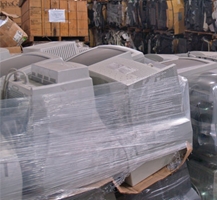 |
 |
| A virtual coffeehouse for
technological minds and ideas |
|
A Fond Farewell To The Cathode Ray Tube
Colored LCD displays required several technological breakthroughs in order to become practical. The first black character LCDs only had to change the crystals’ state from transparent to opaque. By comparison, colored displays had to have three primary color cells (red, green, & blue) for each pixel, which could be made translucent to the backlight source and render true-colored images when modulated. The principle was simple enough but it took some advancements in chemistry to develop the right colored crystals, and some advancements in electronics to develop the modulating circuitry that could be incorporated into the screen without being too large and affecting the image quality. Beyond these issues though, an LCD display renders images in a rather simple and straightforward way. It uses a two-dimensional array of pixels that are modulated to directly correspond to the digital array generated by the equipment that drives it. This is where the difference with cathode ray tubes is significant and interesting. Cathode ray tube technology began evolving with our understanding of the electron, and what we could make it do inside of a vacuum. This is knowledge that we take for granted today but keep in mind that in the late 1800s, when this work began, the electron was not even known of as a particle of matter. In 1880, when Thomas Edison was working to perfect the incandescent lamp, it was noticed that some of the carbon from the lamp filament was being emitted from one end of the filament and depositing onto the inside of the vacuum bulb. To investigate this effect further, he and his assistants built a vacuum bulb with an additional electrode and measured a current flow to this extra electrode through the vacuum inside the bulb. They patented this device, but did not pursue it any further since they did not fully understand it and because it was distracting them from their primary purpose of making a working light bulb. In later years this device became known as the Edison Effect Bulb and was considered a precursor to the vacuum tube. At the same time a scientist named Sir William Crookes was experimenting with electron emissions inside vacuum tubes. These became known as ‘Crookes Tubes’, and were the first known devices in which an image was projected using an emitted stream of electrons. In the “Maltese Cross” Crookes tube the electrons traveled in a straight path that was partially blocked by a metal plate in the shape of a cross and produced a glowing reverse image on the opposite glass face of the tube. In another type of Crookes Tube a charged plate is used to deflect the electron beam in varying degrees, and is the beginning principle behind which modern cathode ray tubes produce their images. Karl Ferdinand Braun took the Crookes tube a step further in the early 1900s by placing a phosphor coated screen inside the tube. Electrons striking this screen would excite the phosphor and make it glow wherever it was struck, allowing different patterns to be seen as the electron stream was manipulated. This allowed these tubes to be used as electrical measuring instruments by providing a visual display of the strength and variation of electrical charges and signals. Further refinements and features brought about the invention of the oscilloscope, which is still used today. The golden age of the cathode ray tube came when Philo Farnsworth used one as the receiver display for his first television transmission in the late 1920s. When he was able to transmit and display the human image of his wife’s face the potential of electronic television was realized. Subsequently commercial investments from companies like RCA and Philips allowed developments that significantly improved the size and image quality of these tubes. From these developments came the modern TV and the common computer monitors that are now fading in use. As we retire these heavy, obsolete, electronic dinosaurs from our desktops and living rooms we should at least consider the genius and discovery of the past that brought us so much entertainment and information for so many years. P.H. |
add to favorites
|
 del.icio.us
del.icio.us
 Slashdot It!
Slashdot It!
 Stumble It!
Stumble It!
Home | About Us | Advertise | Submit an Article | Submit a Link | Contact Us
ElectronCafé.com is a registered property of electricalfun.com Copyright © 2008 - All rights reserved
 One of the most rewarding hardware upgrades I’ve
made in the past several years has been replacing my old 17” CRT
monitor with a new 19” LCD (liquid crystal display) flat-screen
unit. There was also a little sadness in it, however. Even
though the LCD monitor is superior in most ways (resolution,
clarity, power consumption, and desk space), the cathode ray
tube was an absolutely ingenious invention for its time and
deserves some appreciation.
One of the most rewarding hardware upgrades I’ve
made in the past several years has been replacing my old 17” CRT
monitor with a new 19” LCD (liquid crystal display) flat-screen
unit. There was also a little sadness in it, however. Even
though the LCD monitor is superior in most ways (resolution,
clarity, power consumption, and desk space), the cathode ray
tube was an absolutely ingenious invention for its time and
deserves some appreciation.